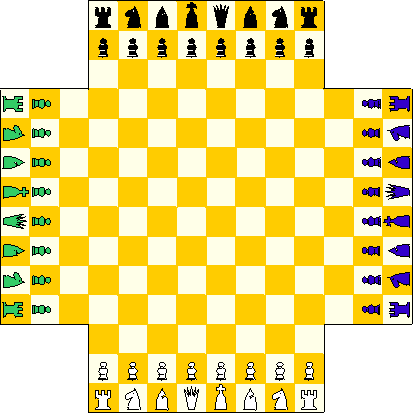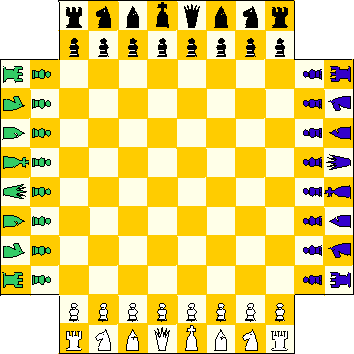Four Handed Chess (I)
For more than two hundred years, people have invented and reinvented chess variants for four players on a board, formed by adding a few (two, three, or four) rows to each side of an eight by eight board. In the opening setup, there are four sets of the 16 usual pieces, one on each of the four sides of the board, in four different colors.Some historic and modern chess variants from this family are described here. See also:
- Bishops. Commercial 4-player chess variant.
- Chessapeak Challenge. Commercial 4-player chess variant, with markings on board that change pawn direction.
- Four handed chess: a book from 1881.
- Four players chess. Commercial variant. (Link.)
- Vendetta. Photo's of commercial four handed chess set.
Common rules
Most variants use the following rules - deviations will be noted.At each side, we see a set of pieces in a different color, with a usual setup. Setups between variants often differ in the placement of queens (a detail that is important for playing, as attacks on kings may be easier when queens and kings start on the same line.)
Players form teams - each team consists of two players that sit opposite of each other (like in bridge.) Players take turns, either clockwise or anticlockwise. All pieces move like in orthodox chess. Friendly kings may be at adjacent squares.
The object of the game is to mate both opponents; when a player is mated, then his pieces become immobile and he passes his turns. When the mate is released, he can resume play.
When his king is in check, a player must resolve it himself - he cannot wait for his partner to resolve the check on his own king.
The game of Dessau
The first member of this family, described in The Encyclopedia of Chess Variants is dated at 1784. The inventor is only known by initials K.E.G. and place Dessau.
In this variant, all queens are on white squares in the opening setup.
Pawns have no initial double step. When a player is released from mate, his pieces may not be taken until after his next move.
Altenburg
A few years later, in 1792, the first variant with a board with extensions of `width' two is reported in the German town of Altenburg.

In this variant, pawns on rooklines are not allowed to capture each other from their starting position.
More variants
Almost twenty similar games are mentioned to have appeared in the period till 1880 in The Encyclopedia of Chess Variants. The common characteristics are large, but the games vary in little, but sometimes for play important details, like the number of added rows (2 or 3), pawn movement and promotion, rules about whether pieces of a mated player can be captured or not, and queen and king placement in the opening setup. The game was popular mostly in Germany and Great Brittain, but also in other countries, like the United States.More
In 1881, one of the most well known and widely played four handed chess variants appeared in London.Read: Four Handed Chess II.
Written by Hans Bodlaender.
WWW page created: May 4, 2000.
